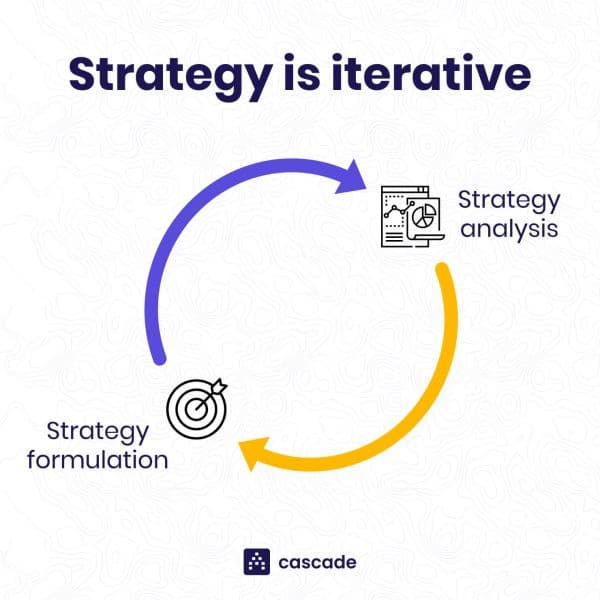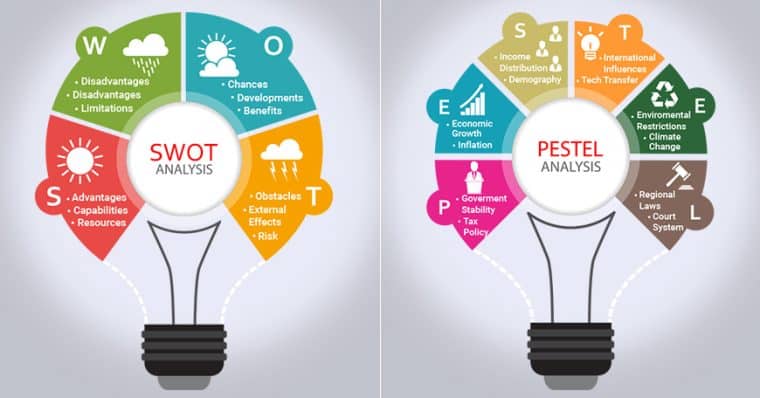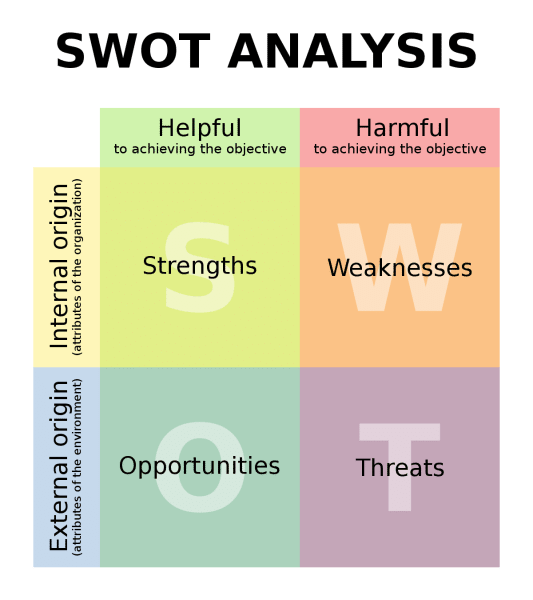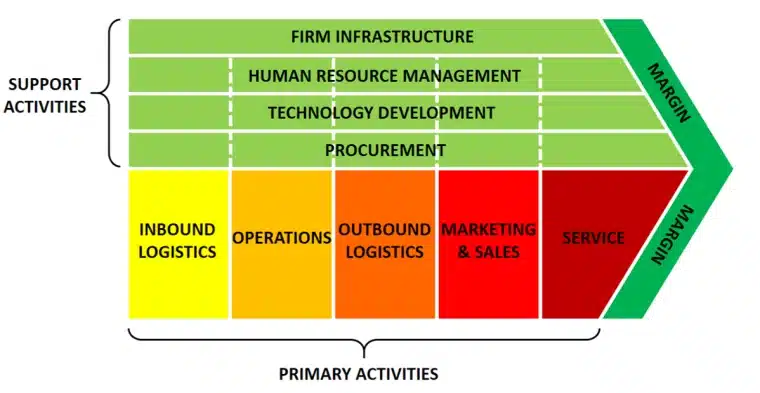As a business owner or decision-maker, you’re likely familiar with the concept of strategic planning. However, planning for your company’s future can be challenging without a true assessment of how your business is performing right now and how external and internal factors can affect your ability to reach your goals. Strategic analysis is often lauded as the best tool to use to get the information and insights you need to move forward with planning.
Discover the tools, templates, and methodologies that empower strategic decision-making in your company to begin steering your business in the right direction.
What Is Strategic Analysis?
Before you can properly conduct a strategic analysis, it’s important to define “strategic analysis” and understand how it can help you craft a good strategic plan. Here’s a basic definition, along with an in-depth explanation of why these considerations are important for business owners.
Understanding the Basics
Strategic analysis is all about gathering data on a company’s internal and external environments to choose the priorities and goals that will shape the organization’s long-term strategies.
It puts data points into context so business leaders can properly analyze them and use the information to develop an optimized action plan for moving forward. In doing so, it determines the company’s direction and provides guidance for all operations teams on how to reach long-term goals.
Strategic analysis helps business owners improve strategies by understanding the various factors that affect them, including internal strengths and weaknesses, the political environment, greater market competition, and social and economic trends.
This crucial type of planning allows organizations to navigate challenges and seize opportunities, as they can get a better sense of how to adapt and respond to changes. While other companies may be caught off guard by internal or external issues, those whose leaders regularly perform strategic analysis will know where and how to pivot.
When to Conduct a Strategic Analysis
Make both external and internal strategic analysis a regular practice in your business by performing a comprehensive analysis every three to five years.
It’s also a good idea to conduct a smaller strategic analysis annually, revisiting your data and findings for the previous year and adjusting for what may happen in the coming year. Your business and its environment are always changing so your strategies will always need to be iterated upon. Some kinds of businesses will have to refresh their strategies more often than others, however. 
Additionally, consider conducting a strategic analysis in the following scenarios:
- When your company is facing a tactical challenge, such as new legislation that makes it difficult to move forward with previous priorities and goals
- When company leadership makes a sudden decision to shift directions, a revision in goals and priorities becomes necessary
- When there have been significant internal or external changes in the company or external environment, such as a new CEO, a merger or acquisition, an external cultural shift, or a significant employee exodus
No matter the frequency, regular strategic analysis will help leadership teams overcome challenges instead of continuing in a direction that no longer works for the company or puts the company at a disadvantage among more agile competitors.
Who Needs to Conduct Strategic Analysis?
The entire leadership team, as well as any team member or project manager who’s involved in strategic planning or making important decisions for the company, should be able to harness strategic analysis as their results will inform these responsibilities.
Along with these key players, you should make it a point to poll anyone who can help you understand your organization’s strengths and weaknesses for their opinions. This is especially important if they can give you access to the data that shapes their analysis.
How to Conduct a Strategic Analysis
Conducting a strategic analysis requires you to have the right tools and team members on your side. Here’s a rundown of what you’ll need in order to effectively carry out this critical process.
Essential Steps
There are five essential steps to conducting a strategic analysis. Here’s how to get started:
1. Decide What Level of Strategic Analysis You Need to Perform
Are you going to analyze data for the overall corporation or are you looking to improve a specific function for a specific goal, such as improving HR processes to better retain your workforce?
2. Select Team Members to Take Part
Your entire board and leadership team should be involved in the process, but you’ll also want people who represent different operational departments, including finance, HR, sales, marketing, and any other major areas of your business.
3. Choose the Strategic Analysis Tool(s) You Want to Use & Dive In
Use tools like SWOT or PESTLE in concert with one another to conduct your analysis. Make sure you inform the team you selected in the previous step so they can provide the necessary data that supports your chosen framework.
Work together to collect and interpret all of the relevant information that you have gathered. If you aren’t sure what to look for, don’t worry. We’ll dive into each of the main types of strategic analysis methods below.

4. Summarize Your Findings
Once the meeting is over, you’ll need someone to summarize the findings in a way that’s easy to understand and act on. It may be helpful to approach this task as a team.
5. Create Goals and Priorities Based on Your Analysis
Use these objectives to decide on the projects and processes that will help you get the job done. Depending on your chosen analysis tool, consider what weaknesses you need to mitigate and what strengths you should leverage to accomplish your mission.
Keep in mind that strategic analysis isn’t a done deal once this process is over. You’ll create a “living document” that you can return to revise as internal or external conditions change.
Strategic Analysis Tools & Methods
Most companies use one (or more) of three tools when conducting strategic analysis: SWOT, PESTLE, or value chain analysis.
SWOT Analysis
SWOT stands for “Strengths, Weaknesses, Opportunities, and Threats.” In this internal analysis method, you’ll look at:
- Positive attributes or resources that are aiding in your success (strengths)
- Important attributes or resources that you lack (weaknesses)
- Events or circumstances your company can take advantage of to succeed (opportunities)
- Things that might prevent your company from reaching its goals (threats)
This type of internal analysis helps you evaluate your performance and position your company for continual improvement.
PESTLE Analysis
Unlike a SWOT analysis, PESTLE is a type of external strategic analysis that focuses on factors that might impact your company’s success, such as the following:
- Political: Moves made by world leaders, like enacting tariffs or placing restrictions on visas
- Economic: Trends affecting the economy, like booms, recessions, interest rate hikes, or inflation
- Sociological: A change in cultural norms or public opinion, such as a shift in spending habits or desire for new products
- Technological: New and emerging technologies that will likely impact how you do business
- Legal: New laws (or changes to old ones) that may affect your industry
- Environmental: Regulations and public sentiment that can affect your policies and procedures
This type of external strategic analysis helps you account for anything that may get in the way of achieving your business goals.
Value Chain
A value chain analysis looks at the business activities and processes that relate to the delivery of your product or service. This strategic analysis process is broken down into primary and secondary activities.
Primary activities include:
- Inbound and outbound logistics
- Operations
- Marketing and sales
- After-sales services
Secondary activities (also known as support activities) include:
- Procurement
- Technological development
- Workforce/HR management
- Infrastructure

To conduct your analysis, you’ll consider the cost of each activity and how it adds value to the process of delivering your product or service. You’ll then evaluate it through the lens of your end goals.
For instance, if you’re trying to reduce costs, what activities can you eliminate or make more efficient? If you want your product to stand out, which activity presents the best opportunity to make that happen?
Strategic Analysis Examples
Here are a few examples of how organizations might use strategic analysis:
1. Local government
A local government is struggling with rising crime rates but it doesn’t have enough information surrounding the problem to effectively combat it. It decides to complete a thorough strategic analysis by working through both the PESTLE with SWOT methods to analyze crime and case trends.
Once the analysis is complete, the government has a vastly better understanding of the problem, making it infinitely easier to determine the best ways to fight it. It found that understaffing of low-level police officers and public defenders seems to be the main culprit so it passes a law to add greater incentives for new hires.
2. Large media corporation
A large media corporation has started to see lower viewer counts and worsening reviews on one of its flagship shows. Executives decide that they need to turn the show around but aren’t sure what the biggest problems are so they build a PESTLE strategic market analysis of changing consumer sentiment about TV show content.
The analysis finds that viewers were unhappy with the show covering especially controversial topics, which the leaders were able to easily rectify by speaking with the producer of the show.
3. Small grocery store
A small grocery store wants to raise its profits so that it can expand to another larger location. The owner decides to use value chain analysis to determine the store’s best opportunities moving forward. He finds that he is making vastly higher margins on store-brand items but that his marketing and placement for these products are lacking.
Using this information he reorganizes the store to more prominently show store-brand items over national brands and launches a marketing campaign for his most successful products.
These methods of analyzing current and future challenges and opportunities aren’t just useful for massive international companies. Any company, large or small, can gain valuable insights from them.
If you want another strong example of strategic analysis in practice, take a look at 365 Financial Analyst’s recent video analyzing Starbucks.
Tips to Make a Good Strategic Analysis
To make the most of your strategic analysis efforts, it’s important to understand both what to do and what not to do.
Best Practices
While your company’s process of strategic analysis should be unique, there are some best practices that can help you optimize it:
- Keep your comprehensive analysis to high-level, organization-wide activities and processes; if you prioritize individual departments, you won’t have time to consider the company’s long-term goals
- Create a visually appealing, easy-to-understand presentation of your analysis findings, which not only helps with implementation but also garners buy-in when and where you need it
- Look to both the past and the future in your analysis — you need past data to faithfully analyze your performance and predict what you can expect in the future
- Remember that you may need to conduct a strategic analysis more frequently if you operate in a fast-paced industry or one that’s influenced by rapidly shifting cultural sentiment
Following these general guidelines will help ensure maximum effectiveness each time you conduct a strategic analysis.
Common Pitfalls
Watch out for these common mistakes as you perform your strategic analysis:
- Not being realistic in your assessment
- Not considering both today’s circumstances and possible future conditions your business may face
- Not having a clearly defined goal for your analysis
- Relying on a single tool for all your strategic planning duties
Avoiding these mistakes will greatly enhance the quality of your assessments and, in turn, the viability of your strategy formulation.
Use Strategic Analysis to Dominate the Market
The business world changes at an unprecedented pace. Regular strategic analysis can offer a competitive advantage by enabling you to anticipate and respond to various challenges and opportunities.
When you put time and effort toward integrating these insights into your organizational decision-making process, you’ll be in a much better position to reach your long-term goals and take your business to the next level.
